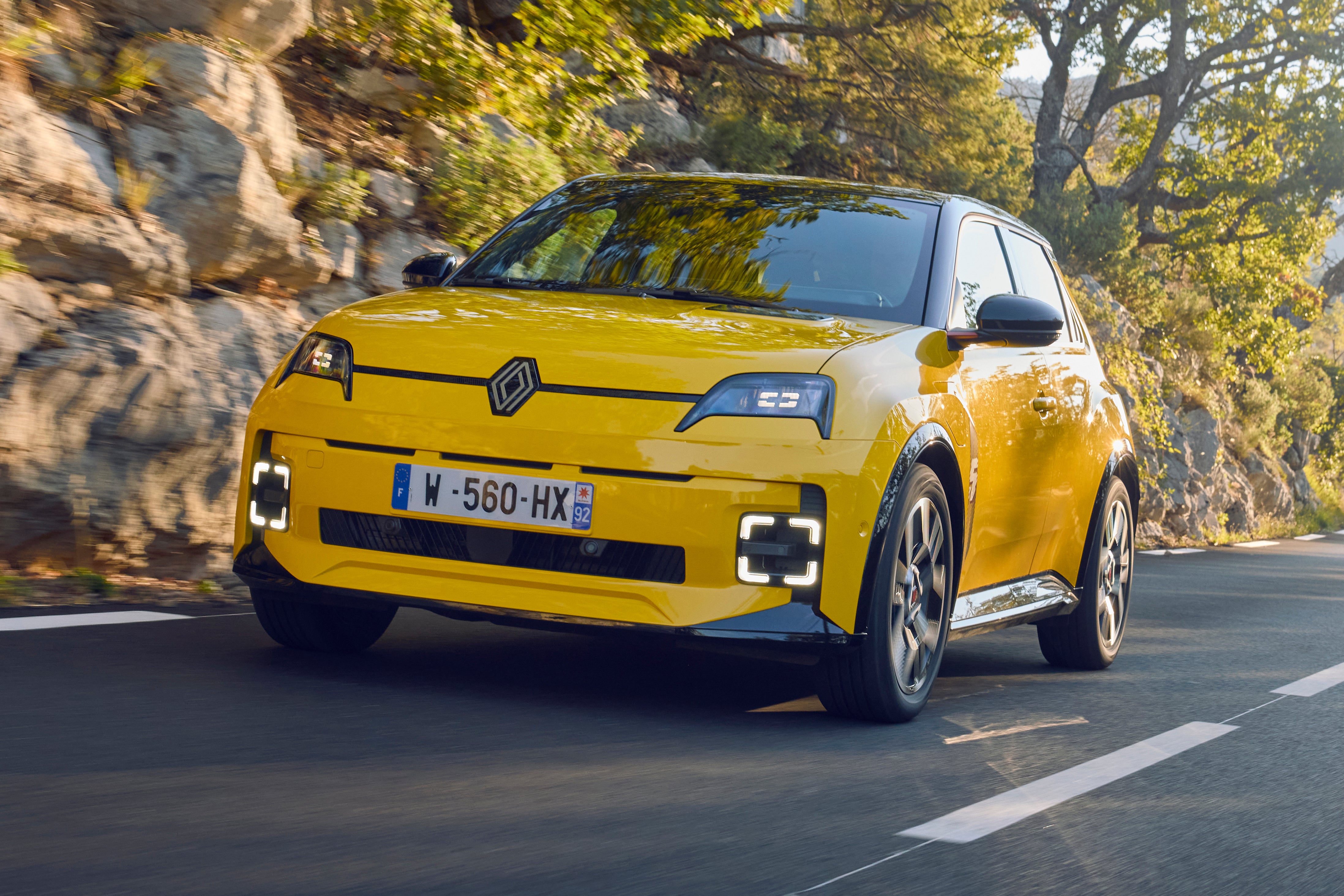Renault 5 Review 2025: Price, specs & boot space
Written by Antony Ingram
Quick overview
Pros
- Fabulous styling
- Well-judged ride and handling
- Good value
Cons
- Limited rear seat space
- Awkward gear selector
- We’re yet to try the cheaper 40kWh car
Overall verdict on the Renault 5
“Renault hasn’t done things by halves in bringing back one of its most beloved shapes and nameplates from the past. The new Renault 5 is one of the best electric superminis out there, with traffic-stopping styling and pricing that seems more than fair for what it offers. The MINI Cooper E finally has a real fight on its hands.”
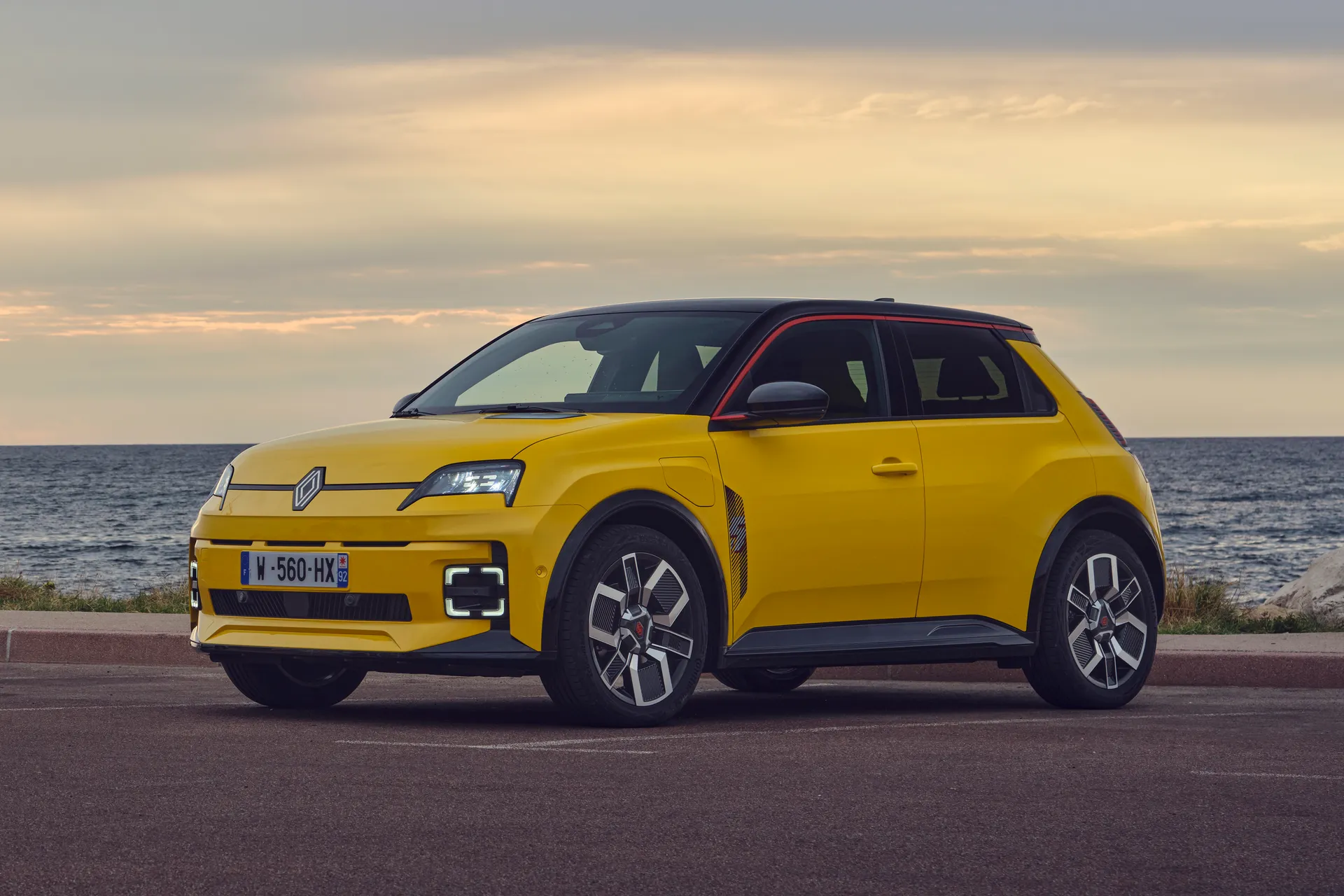
Forget supercars: 2025’s most eye-catching car is sure to be the new Renault 5 E-Tech. That’s great news, because while an electric vehicle priced between £23,000 and £29,000 can’t exactly be considered “cheap”, it’s certainly within the reach of plenty of normal folks with normal budgets, and at this price, not even the latest MINI Cooper E stands out on the road as much as the Renault.
If you hadn’t guessed from the name and the look, the Renault 5 E-Tech pays homage to the brand’s first supermini, introduced in the 1970s and sold through to the mid-90s. It’s one of Renault’s most beloved models, especially in its home country, and was a bit of a small car revolution in its day – a spirit it’s hoping to capture with the new car.
There’s nothing quite like it. The Renault 5 is conventional in that it’s a small, five-door hatchback, and modern in that it has electric power and all the latest tech, but at this early stage at least, its design is eye-catching like few other cars. It’s full of neat details too, from the detail on the bonnet that shows your state of charge in 20% increments, to the chunky squared-off arches and some truly vivid colour options.
And it gets all the basics right. Rear seat space aside, it has a great interior, is comfortable, has a decent boot, plenty of equipment, and an intuitive infotainment system. It also drives and performs well and offers up to 252 miles of range, while pricing is class-competitive and arguably quite good value given what the Renault 5 offers in terms of range, performance, kit, and style.
Is the Renault 5 right for you?
At the intersection of a compact body style, decent electric range (over 200 miles in the real world), and a dash of style, the Renault 5 E-Tech is pretty hard to beat right now. If you want a small car and want it to be electric then the Renault absolutely needs to be on your shortlist, because it’s competitive on range, performance and price before you even consider how good it looks, how smart the interior and technology is, and the driving experience. The only real reason to discount it is if you regularly travel with taller passengers in the rear seats, as the Renault 5 does fall down here compared to some rivals, and some similarly-priced but physically larger Chinese electric models.
What’s the best Renault 5 E-Tech model/engine to choose?
There are a couple of battery options, a couple of power outputs, and three trim levels in the new Renault 5 E-Tech. So far we’ve driven the top-spec 52kWh, 150PS car in Iconic trim which still feels like a pretty good package for its £28,995 price tag and has a fantastic feel-good factor, though we suspect the Techno model a rung down, for a few grand less but with the same 52kWh battery pack, could be the smart deal. If you tend to stick to town driving and don’t need as much range, there’s an argument to be made for the entry level Evolution with the smaller 40kWh battery, which will be priced around six grand cheaper than the top model.
What other cars are similar to the Renault 5 E-Tech?
Your selection of electric superminis and small cars has definitely got broader in recent years, with existing models like the Peugeot e-208 and Vauxhall Corsa Electric being joined by the Fiat 500 Electric, Citroen e-C3, Dacia Spring, and what’s sure to be the Renault 5 E-Tech’s closest rival, the MINI Cooper Electric. In that little lot there’s a mix of range figures, cabin space and door counts, though in terms of pure numbers, the Renault is pretty competitive, and it arguably has all of them beaten on desirability.
Don’t forget the used options though, not least the Renault Zoe that the 5 E-Tech effectively replaces and still has decent range for its size on its side. The Honda E and older MINI Electric are also options, but don’t expect more than a real-world 100 miles from either.
Comfort and design: Renault 5 interior
“The new Renault 5’s interior is only marginally less striking than the outside. It looks and feels great and while it could be more spacious, the materials and quality are both impressive.”
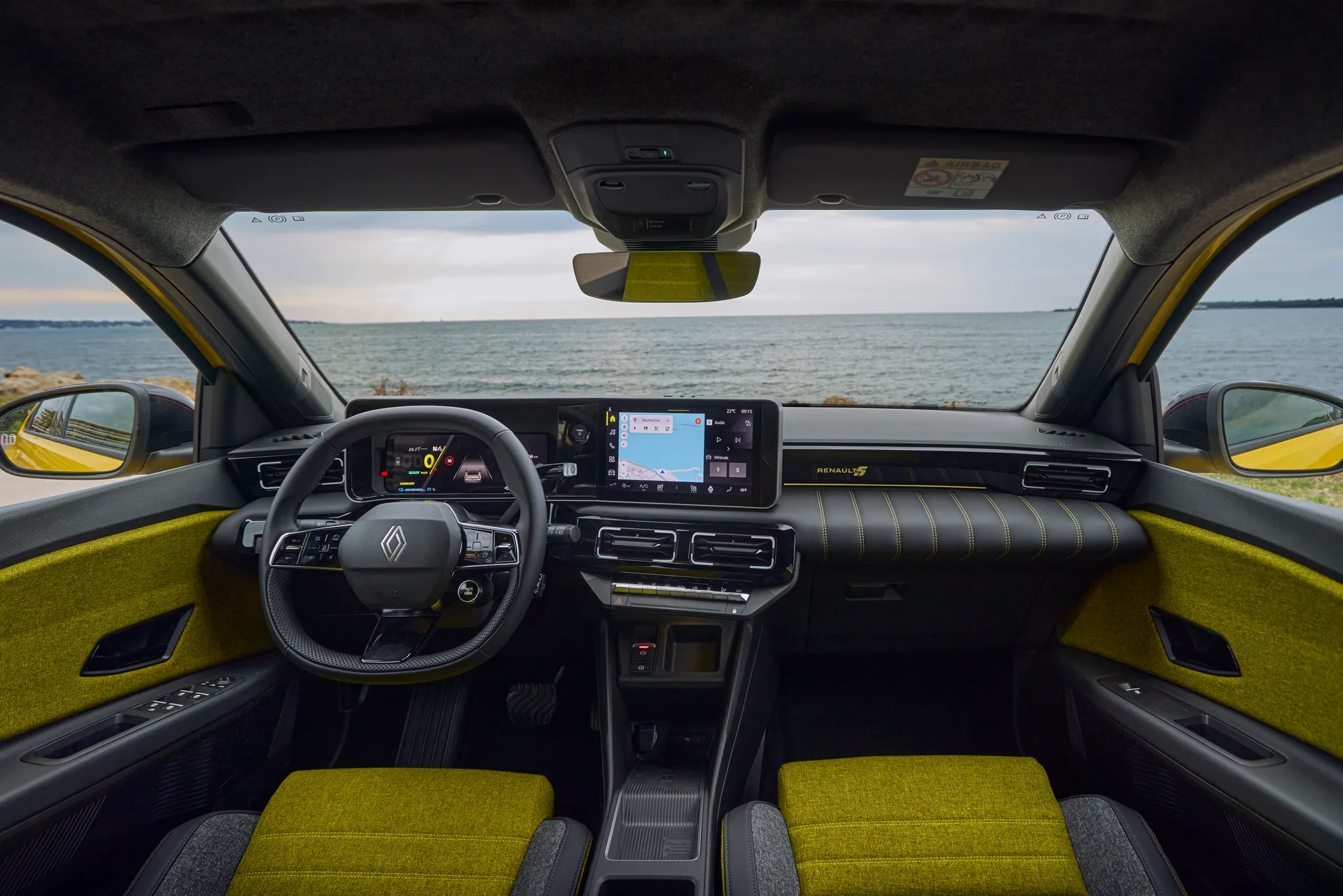
We’ll get to cabin space later, as it’s not all great news, but purely in terms of comfort, the Renault 5 E-Tech scores well. In our top-spec Iconic test car, the seats were frankly fabulous – not just their retro design and colour scheme, a nod to the wild wide-arched Renault 5 Turbos of the early 1980s, but the well-bolstered design and wide range of adjustability make them comfortable for hours behind the wheel and decently supportive in enthusiastic cornering too.
Overall too this might be among our favourite modern cabins. There’s nothing particularly novel about the wide two-screen display in front of you, since many modern cars have a similar layout, but it’s well-implemented and suits the chunky, retro-inspired look that Renault has implemented elsewhere – such as the ridged passenger dash, another tip of the beret to classic Renault 5s.
Then there are the neat little touches everywhere: the grid-style roof lining, the tasteful and smart use of coloured fabrics and stitching (and the feel of those materials), and intelligent use of physical switches where required. The squared-off gear selector is also interesting and can be customised with 3D-printed parts, but ergonomically it’s not perfect, partly because it shares space on the right-hand side of the wheel with both the wiper and audio stalks. More than once we set the wipers to full speed rather than selecting drive…
Quality and finish
This is another step in the right direction for Renault, after the excellent Megane and Scenic E-Tech models. No squeaks or rattles, a solid feel from the moment you get in the car, a tactile feel to all your touchpoints (the seats are a particular highlight, with a tweed-like finish that’s warm, comfortable, and pleasingly textured), and a thoughtfully minimal use of fingerprint-attracting gloss black plastic, which always cheapens the feel of a car.
We have just one reservation, which is that the passenger door on our left-hand drive test car was slightly misaligned, and beginning to rub the paint off both it and its neighbouring front wing. But since these first drives tend to take place in early production and even pre-production vehicles, and none of the other cars on the launch had the issue, we suspect it was a one-off incident.
Infotainment: Touchscreen, USB, nav and stereo in the Renault 5
Renault has been nailing the infotainment experience in its recent cars, so it’s no surprise that the 5 E-Tech continues this trend. Once again you get a pair of screens in front of you, and software is Google-based, which generally makes it intuitive, and has the benefit of Google Maps built in. Most of us are probably familiar with that so it takes minimal learning and is one of few systems where you won’t immediately feel the need to plug in your phone (which you can still do, of course).
As Google Maps is embedded too, it has a few useful functions, such as knowing (with pretty impressive accuracy) how much charge you’ll have when you reach your destination, or where you might like to stop to top-up along the way. Outside of the mapping functions, the screen operates quickly and easily too.
The graphics perhaps look a little busy in places but usability is still fine – you won’t have to take your eyes off the road for long to find pertinent information. Nor will you need to faff around in the screens to change the cabin temperature or fan speed, since there’s a row of physical buttons for this below the vents.
One final detail is “Reno”, the Five’s AI-powered and diamond-shaped digital assistant. We presume the French pronounce it like the car brand, or the actor from Leon and Ronin, but with everything set to English, it’s pronounced more like the city in Nevada. We didn’t get a chance to test it out, but the car’s basic functions are simple enough it wasn’t required, either.
Space and practicality: Renault 5 boot space
The Renault 5 E-Tech is a snip under four metres in length, and this defines its practicality. A lot of modern superminis have ballooned beyond this in order to maintain interior room while the need to package safety gear, comfort and tech has increased, but the Renault is still genuinely small by modern standards.
The tradeoff has to come somewhere, and in the 5 it’s the rear seats, which are comfortable but a little cramped on knee room in particular – putting a 5’8” passenger behind a 5’8” driver is about the limit, so families with tall teenage offspring may hear some complaints. Up front, things are much more like it – in the top-spec Iconic at least, there’s loads of seat and wheel adjustment, and while chunky pillars could make you feel a little hemmed-in, bright colours do a good job of compensating.
One of the reasons for the cramped rear quarters is that Renault has prioritised boot space, and at 326 litres there’s a decent bit of it back there – that’s 116 litres more than you’ll find in a MINI Cooper E, and more even than the larger Peugeot e-208’s 311 litres. It should be fine for most supermini buyers either way.
Handling and ride quality: What is the Renault 5 like to drive?
“The Alpine A290 will serve the proper hot hatchback role for the Renault 5, but the regular car strikes a well-considered balance of ride and handling, comfort and fun, and performance and refinement.”
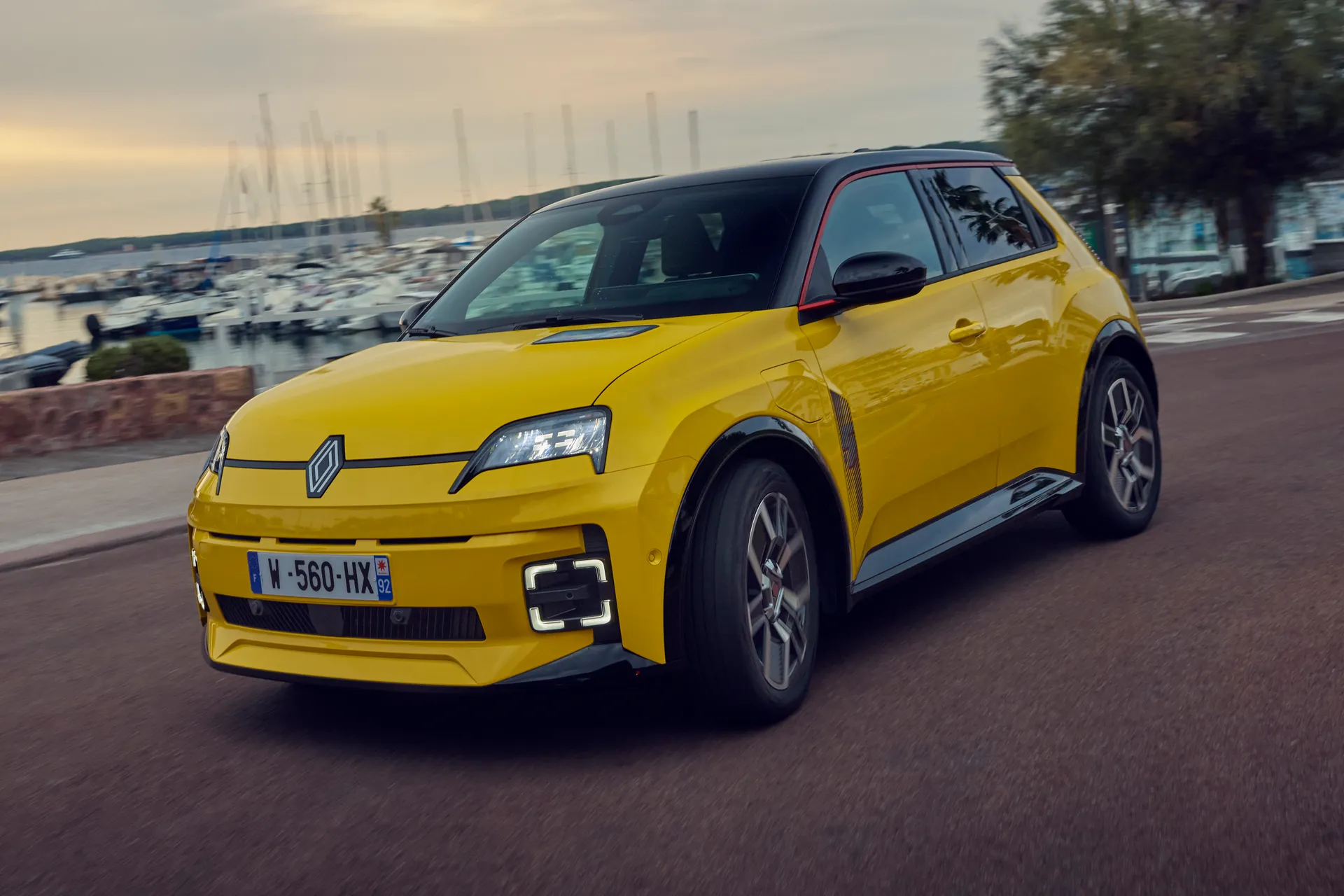
The Renault 5 delivers the typical modern electric supermini driving experience, with just a few flashes of character here and there to separate it from the marauding silent hordes. It is, naturally, an absolute doddle to drive, once you’ve figured out the steering column mounted gear selector and haven’t mistaken it for the wiper stalk.
There’s a slightly firm feel to the ride quality but not an uncomfortable one – more a well-judged tautness that doesn’t try to completely smother bumps but does take them in its stride, and rounds off their edges so you don’t get any uncomfortable thumps or bangs. Ordinarily we’d suggest going for a smaller wheel option if you really want to take the edge off but 18-inch wheels are the only option here – though perhaps because of this single wheel choice, Renault has been able to really tune the suspension to work with them, rather than compromising for umpteen different sizes.
The steering has a light, direct feel and is responsive without being twitchy – pretty much perfect for a car like this, since it works in town, on country roads, and on the motorway equally well. And when you start lobbing the 5 into corners in true small-car fashion, that taut ride comes into its own, since there’s little body lean and neat, tidy handling that doesn’t fall apart as the speeds rise. You can feel the weight in the car’s responses, and over undulations there’s a little more movement than you’d find in a lighter car, but generally Renault has judged the balance between ride and handling pretty well.
It’s quite good fun in fact, and feels pretty foolproof - there are safety systems in place to reduce the chance of trouble of course, but on dry roads it rarely calls them into action even if you’re being a little silly. The Renault 5 has one other ace up its sleeve too: an excellent turning circle. Those front wheels cut quite an angle, so low-speed driving, and parking, is an absolute breeze.
What motors and batteries are available in the Renault 5?
There are two battery options in the new 5 and they’re tied to different motor outputs. So the smaller 40kWh pack comes with a 120PS motor, and the 52kWh battery is paired with a 150PS motor. Those motors sit at the front axle and drive the front wheels too, just like this car’s Renault Zoe predecessor, and indeed the classic Renault 5 (well, mad mid-engined Turbo excepted).
Renault hasn’t yet provided performance figures for the less powerful car, but the 150PS model will get from 0-62mph in an easy-going 8.0 seconds – not blistering by EV standards, but quicker than some of the entry-level hot hatches of recent years such as the Suzuki Swift Sport and Volkswagen Up GTI.
The number accurately relates how it feels on the road too: there’s not the kick you get with more powerful EVs, but the Five is brisk off the line and has some reasonable mid-range punch too, only tailing off at motorway speeds, though it’s still pretty relaxed and has a little more go to spare at 70 – top speed is limited to 93mph.
Being front-wheel drive, it feels like Renault has sensibly calibrated the power to ramp up from a standstill rather than delivering it all at once, so on dry roads at least, it’ll only really spin the tyres out of junctions and tight hairpins, and there’s not much fighting or tugging at the steering wheel under hard acceleration. Regenerative braking could be a little stronger for our tastes though – it’s effective at slowing the car down, but true one-pedal driving isn’t really possible, and you do need to lean on the (nicely firm) brake pedal now and then.
Maximum electric range in the Renault 5
Renault hasn’t yet quoted a range figure for the smaller 40kWh battery pack, but the larger 52kWh battery is good for 252 miles in theory – on the pace for a car in this class. A heat pump on every model is better than you’ll find in many rivals though and should help mitigate the usual range loss you’d get in very cold or very hot conditions.
Out of the laboratory and on actual roads, we found figures of more than four miles per kilowatt-hour fairly easy to achieve, which means that if you exhausted a full battery pack, you’d travel just shy of 210 miles, again not bad for the class, though some similarly-priced Chinese EVs with larger batteries will go further.
To put the range figure into another context though, we only used up about half of the car’s battery in five or six hours of mixed driving (town, motorways, and very twisty roads around Nice in the south of France). For every hill that drained range a little faster, we could coast down the other side and regenerate most of that energy.
Refinement and noise levels
Electric vehicles always get off to a pretty good start with refinement, and in the Renault 5’s case, motor noise is basically absent – the only sound you’ll hear at low speeds is the slight hum of the system designed to alert pedestrians of your presence. No augmented noise either, unlike the loud engine-style blare you’re offered by an Abarth 500e.
Despite the retro-inspired trapezoidal shape and some boxy-looking angles, there’s not a great deal of wind noise as speeds rise either, and tyre noise is also well insulated. The suspension and sense of integrity to the car help here too, as bumps don’t cause rattles or thumping noises through the cabin.
Safety equipment: How safe is the Renault 5 E-Tech
There are no EuroNCAP crash test results yet for the Renault 5 E-Tech. Renault has traditionally had a pretty good record here – it was the very first company ever to be awarded a five-star rating for one of its cars – and while it no longer seems to shoot for those top ratings in the way it once did, its cars are still considered safe. For some comparison, the closest current Renault in size to the new 5 is the Clio, and that has a five-star rating, while the 5 sits on a brand new platform where safety has surely been a priority.
Standard active safety kit is impressive for a car in this class too, with the kind of features usually found on models a size or two bigger: there’s lane keep assist with sensors both front and rear, automatic emergency braking with a reversing function, active driver assist, parking assist, driver attention alerts and more – Renault says there are 26 systems in total.
For those who prefer not to be beeped at by the dashboard on every journey, Renault also has one of the best implementations of any manufacturer for switching everything off. You set your preferences in the touchscreen, once, and then double-press a physical button on the dash each time you get in the car to instantly call up your preferred settings.
Charging times: How much does it cost to charge the Renault 5?
“Decent efficiency and 100kW charging mean topping up the Renault 5 E-Tech shouldn’t be too much hassle.”
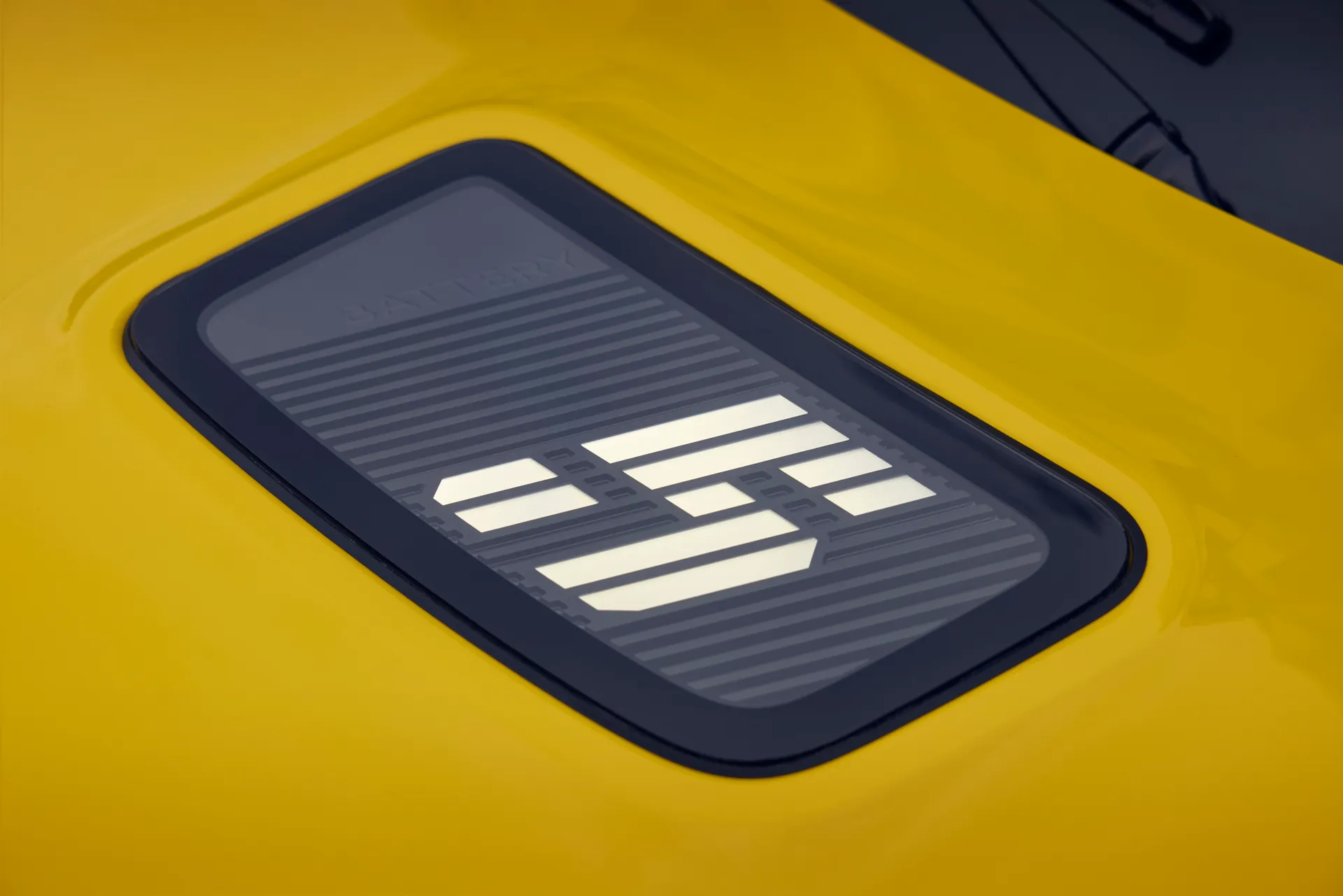
We’ll concentrate on the 52kWh model here as that’s the one we’ve driven. Overall running costs will depend, as they do with combustion cars, on your efficiency, and here we’ll use a realistic figure of 4 miles per kilowatt hour, which is well within what the Renault 5 E-Tech is capable of.
Charge at home on a favourable overnight tariff of 11p/kWh and a full zero to 100% charge will cost you £5.72. Out and about, our 4mi/kWh estimate means you’ll get about 208 miles from a full charge, and if you run that down to 20% (just under 42 miles of range remaining), then a 20-80% charge (60% of the battery’s capacity, or a 31.2kWh top-up) will cost you £23.40 at the typical 75p/kWh rate.
Peak charging rate is 100kW, which is on par with others in the Renault’s class, such as the MINI Cooper E – and perfectly adequate for a car this size. That same 20-80% top up mentioned before should be done and dusted in under half an hour, while with Renault’s 11kW home wall box, 10-100% takes about 4.5 hours.
Renault 5 reliability and warranty
Renault has a bit of a mixed reputation for reliability, and you won’t find the brand in the top ten in the latest HonestJohn.co.uk Satisfaction Index – in fact, it came 28th from 29 positions. To its credit, none of its cars appeared in the worst 20, though none appeared in the top 20 either. For some peace of mind though, Renault has been making electric cars for longer than all but a handful of other manufacturers, so at least it’s not exploring untested technology with the 5 E-Tech.
Renault 5 insurance groups and costs
The Renault 5 E-Tech is so new that we haven't got insurance group ratings for it yet, but the car’s huge suite of safety features should help it here. EVs can be more expensive than petrol superminis, and for some context, the old Renault Zoe went from groups 14-25 depending on spec.
VED car tax: What is the annual road tax on a Renault 5?
The good news is that EVs currently don’t attract any VED or ‘road tax’. The bad news is that by the time customers take delivery of their Fives, vehicle tax will indeed have been introduced for EVs, as it starts in April 2025. The good news again is that for the first year you’ll still only pay a tenner, whcih is included in the cost of the vehicle. However, after that you'll pay the standard annual rate of tax, which is currently £190 but may go up from 2025.
As a company car choice, you’ll be looking at a 3% Benefit-in-Kind rate from the 2025/2026 tax year onwards.
Renault 5 price
“New pricing for the Renault 5 ranges between £22,995 and £28,995, which is similar to most cars in this class. We’re yet to see how depreciation will bring that down.”
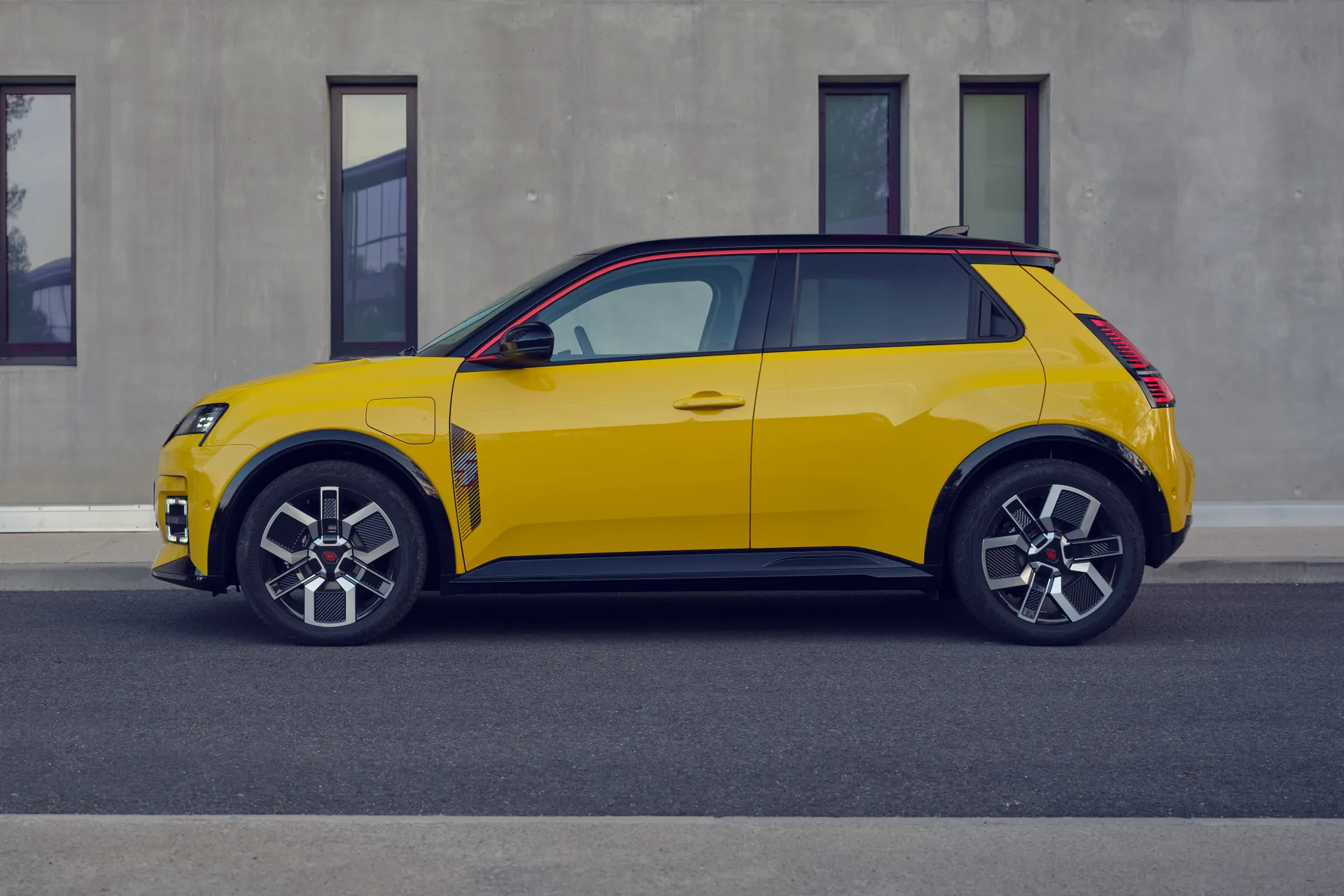
At the time of writing the first customers haven’t yet received their Renault 5s, so you won’t find used models for a while longer.
The Evolution model, with the smallest battery, will start from £22,995. Techno adds another £2000 and Iconic is another £2000 on top of that. The more powerful, larger battery models meanwhile add another £2000 to the cost of Techno and Iconic, so you’re looking at £26,995 for a 52kWh Techno, and £28,995 for a 52kWh Iconic.
That’s pretty good value compared with the Renault’s closest rival, the MINI Cooper E, which starts at £30,000, while the five-door Aceman is nearly £32,000. A larger, 281-mile MG4 SE Long Range starts at £29,495 if you want more than what the top-spec 5 can offer in terms of space and ability.
Trim levels and standard equipment
There are four trim levels to choose from – Evolution, Techno, Iconic Five and Roland-Garros.
The Evolution trim comes well-specced, with 18-inch black alloy wheels, a 7-inch drive display and 10.1-inch infotainm ent screen, with grey and black cloth upholstery on the seats and wireless Apple CarPlay and Android Auto.
Techno adds full LED headlights and upholsters the seats in 100% recycled denim. There's a larger 10.3-inch driver display, and the infotainment system has Google built in. A rear-view camera and ambient interior lighting is also included.
The Iconic Five model has a different design of black alloy wheel, grey and yellow seat upholstery made from receyled textile, with black synthetic leather, and heated front seats and steering wheel. There's also adaptive cruise control and lane centring tech included, along with a blind-spot warning system and a hands-free parking function.
The special-edition Roland-Garros model – named after the Parisian tennis stadium (which in turn is named after a noted World War 1 flying ace) –comes with the option of an exclusive matt Shadow Grey paint colour, with another design of black alloy wheel. There's a St Andrew's cross on the front doors with the Roland-Garros logo, and inside the light grey upholstery is, Renault says, "a cross between sports clothing and upholstery fabric". The front-seat backrests get a Roland-Garros logho embossed on them, and the tip of the gear shifter is inspired by the grip of tennis rackets.
Evolution, Techno and Iconic Five are available with the smaller 40kWh battery pack and 120PS motor, while Techno and Iconic and Roland Garros have the 52kWh and 150PS option.
Ask the heycar experts: common questions
How much does the Renault 5 E-Tech cost?
What’s the best Renault 5 E-Tech model to choose?
Is there a hot hatch version of the Renault 5 E-Tech?
Get our latest advice, news and offers
Keep me updated by email with the latest advice, news and offers from heycar.
By submitting you agree to our privacy policy
